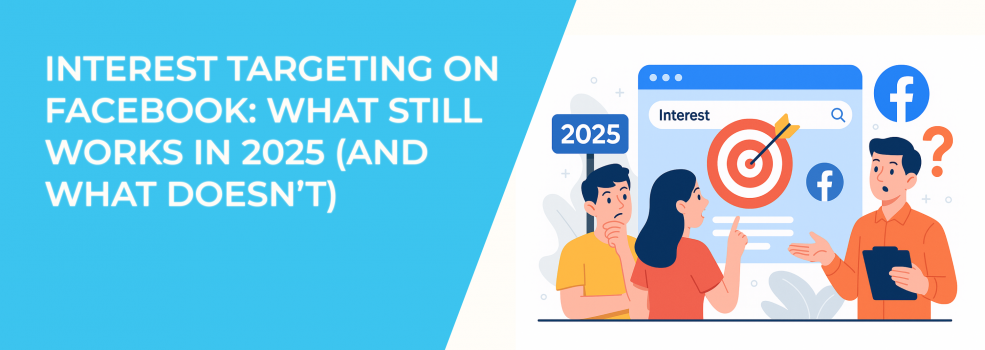Facebook’s interest targeting was once a goldmine for precision advertising. You could isolate small, passionate audience segments — and watch your conversions climb. But in 2025, that landscape is shifting fast. Meta’s latest updates have reshaped what advertisers can (and can’t) do with interest-based targeting.
Some tools are fading, others are evolving — and some might work better than you think.
If you rely on Facebook and Instagram ads to grow your business, now’s the time to reevaluate how you use interest targeting. Let’s break down what still delivers results, what no longer does, and how to move forward with smarter strategies.
Meta's 2025 Updates: Why Targeting Options Are Changing
In June 2025, Facebook rolled out major changes to its detailed targeting system. Many specific interests have been removed or merged into broader categories. So if you're searching for niche interest tags like “Vegan Fitness” or “Vintage Sci-Fi Films,” you might come up empty-handed.
Here’s what’s changed:
-
Interest group consolidation — Many related topics are now bundled under one larger umbrella. For example, instead of targeting "Jazz Guitar" specifically, you might only see a broader "Jazz Music" option.
-
Sunset of detailed targeting exclusions — As of June 10, exclusions based on interests are no longer available for new campaigns or boosted posts.
-
Phasing out legacy campaigns — Campaigns built before June 23 can keep running until January 15, 2026. After that, they’ll stop delivering unless updated.
These updates push advertisers toward broader audience building and rely more on Meta’s machine learning. The platform claims this will improve overall performance, but how does that translate in real-world campaigns?
For a deeper look at how to navigate Facebook’s evolving ad system, check out our breakdown of the latest Facebook Ads Targeting Updates and how to adapt in 2025.
What Still Works: Broader Interest Targeting + Advantage+
Despite losing access to hyper-specific interests, you can still create effective campaigns using broader targeting paired with algorithmic optimization. Meta’s Advantage+ Detailed Targeting helps fill in the gaps by automatically expanding reach to people likely to convert, even outside your selected interests.
To use this approach effectively:
-
Start with a solid base — Use broader categories like “Travel Enthusiasts,” “Small Business Owners,” or “Fitness and Wellness.”
-
Let the algorithm assist — Enable Advantage+ detailed targeting so Facebook can include relevant users beyond your selected audience.
-
Refine with custom audiences — Create lookalike audiences based on website traffic, conversions, or CRM lists to add precision.
Even though you’re casting a wider net, this doesn’t mean your targeting loses relevance. With strong creative and a clear conversion goal, Facebook’s algorithm can learn quickly and improve delivery over time.
Consistency is key. Don’t change your target audience too frequently — allow the system to optimize based on real user behavior.
What No Longer Works: Interest-Based Exclusions and Over-Filtering
Meta has officially removed interest-based exclusions for new campaigns. That means you can’t prevent your ads from reaching users based on certain interests anymore.
What you can’t do:
-
Use interests to exclude segments (e.g., remove “Job Seekers” from a hiring campaign).
-
Rely on saved or draft audiences that include exclusions.
-
Edit or duplicate ad sets with detailed targeting exclusions unless they’re removed.
Instead, Meta recommends alternatives:
-
Custom audience exclusions — Exclude past purchasers, newsletter subscribers, or current clients using your data sources.
-
Account-level audience controls — Use Facebook’s settings to apply restrictions based on brand safety, employment, or sensitive categories.
-
Content-based targeting — Speak to your ideal audience through the message, not the audience filter.
The exclusion ban might seem limiting, but it forces advertisers to get smarter with messaging. Strong creatives and audience-aware content can filter unqualified users without relying on interest-level exclusions.
Smarter Targeting Strategies for 2025
Facebook advertising in 2025 is about balance. While you can’t rely on micro-targeting anymore, you also don’t need to guess wildly. Combining broader targeting with smart data inputs is the most reliable path forward.
Here’s how to stay ahead:
-
Focus on lookalikes — Build lookalike audiences from high-quality sources like purchase events, subscriptions, or app activity.
-
Test broad interest groups — Run A/B tests using broader interests (like “Parenting” or “Home Decor”) to identify segments that perform well.
-
Use dynamic creatives — Let Facebook automatically tailor headlines and visuals to match the user’s profile and behavior.
-
Optimize for high-signal events — Focus on purchases or qualified leads, rather than top-funnel clicks, to feed Meta’s algorithm better data.
The goal is to give the algorithm enough room to find your audience — but not so much that your message gets diluted. With enough testing and creative variation, it’s possible to find the sweet spot.
If you’re not fully confident in who you should be targeting, revisit your foundation with this step-by-step guide to defining your target audience.
Looking for More Control? LeadEnforce as a Precision Targeting Alternative
If the new changes to interest targeting feel too restrictive, there’s another way to reach the right audience without relying on Meta’s limited options.
LeadEnforce offers a different kind of targeting approach. Rather than depending on Facebook’s predefined interest categories, you can build custom audiences based on actual engagement. LeadEnforce allows you to target users who follow, interact with, or show activity in specific Facebook groups or Instagram accounts. These audiences are often more engaged and more relevant than interest-based segments alone.
Here’s how it works:
-
Identify a group or page that aligns with your niche — think local communities, competitor groups, or topic-specific accounts.
-
Create audiences of active users who follow or engage with those spaces.
-
Export those audiences to your Facebook Ad Account via Business Manager and use them just like any other custom audience.
This approach gives you greater control and specificity, especially useful when Meta’s interest options fall short. Whether you're promoting a niche product or testing new segments, LeadEnforce helps fill the targeting gaps that standard tools can't reach.
It’s not a replacement for Facebook’s native targeting. It’s a supplement that adds precision and intent to your ad strategy.
If you’re deciding whether to rely on Meta’s tools or go beyond them, this comparison of LeadEnforce audiences vs interest targeting breaks down which option drives better results and when to use each.
Creative Targeting: Why Your Ads Must Do the Filtering
Interest targeting may have lost some power, but the right ad creative can still filter your audience naturally. If the copy, image, and offer resonate only with your ideal customer, you’re effectively self-targeting — without overrelying on checkboxes.
Here’s how:
-
Use audience-specific language — Speak in ways that your target group recognizes. Jargon, tone, and phrasing can subtly exclude the wrong audience.
-
Visual cues count — Show images that represent your market. For example, a high-end product should look premium and aspirational.
-
Highlight unique value — Position your product or service in a way that naturally appeals to your ideal user — and deters others.
This method doesn’t replace targeting. It enhances it. When combined with Advantage+ and broad interest groups, your creative becomes the final filter — helping the algorithm reach the people who matter.
Final Thoughts: Is Interest Targeting Still Worth It?
Interest targeting on Facebook isn’t gone — it’s just different. And in some ways, that shift opens new opportunities for creative thinking and strategic execution.
Advertisers succeeding today are the ones who:
-
Work with Facebook’s tools instead of against them.
-
Build audiences with broader inputs but sharper messaging.
-
Use platforms like LeadEnforce to recover the precision Meta has taken away.
If your ads feel less effective lately, the issue may not be your product — it could be the audience. Understanding what still works, adapting where needed, and experimenting with smarter tools will help you get back on track.
And if you're ready to take back more control over your targeting, LeadEnforce is here to help.

